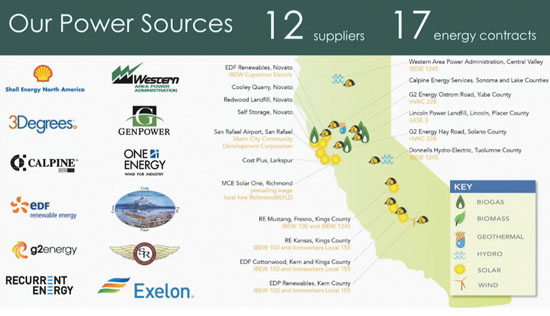|
|
Published February 10th, 2016
|
Moraga Inches Toward Enrolling in Community Choice Aggregation
|
|
| By Sophie Braccini |
 |
| Where does MCE energy come from Graphic provided |
The Moraga Town Council agreed to send a non-binding letter to Marin Clean Energy (MCE), indicating its preliminary interest in having Moraga join the nonprofit structure that competes with PG&E for generating electricity. Other nearby cities, such as Lafayette, are moving forward with MCE (see related story on page A3), while the county is looking into forming an East Bay structure that would generate and/or procure its own renewable energy. The ultimate goal is to give residents the option to either get electricity generated by PG&E or by one alternate structure that secures renewable power at a competitive rate.
 "We are proposing to send a non-binding letter of intent of exploring possible membership," said Assistant Planner Coleman Frick at the Jan. 27 council meeting. MCE proposes what is called a CCA, or Community Choice Aggregation, a nonprofit organization that provides electricity from renewable sources. In this scenario, PG&E continues to transport and deliver the electricity, and bills clients for that part of the service; the CCA includes the electric generation cost to the monthly PG&E bill. "Joining would give consumers a choice and increase the competition. It can benefit all consumers including PG&E's," added Frick. "It would also add a level of local control as a member of the town would be appointed to the CCA board."
"We are proposing to send a non-binding letter of intent of exploring possible membership," said Assistant Planner Coleman Frick at the Jan. 27 council meeting. MCE proposes what is called a CCA, or Community Choice Aggregation, a nonprofit organization that provides electricity from renewable sources. In this scenario, PG&E continues to transport and deliver the electricity, and bills clients for that part of the service; the CCA includes the electric generation cost to the monthly PG&E bill. "Joining would give consumers a choice and increase the competition. It can benefit all consumers including PG&E's," added Frick. "It would also add a level of local control as a member of the town would be appointed to the CCA board."
 Mayor Metcalf asked MCE representative Alex Digiorgio how his company provided electricity to users, even when the wind does not blow and the sun does not shine. Digiorgio explained that it does not really provide individual users with electricity during day and night; what it does is feed the global system the equivalent of what its customers consume, coming from renewable sources, averaging during a one-year period. The electricity sources include wind, solar, geothermal and biomass energy providers in California.
Mayor Metcalf asked MCE representative Alex Digiorgio how his company provided electricity to users, even when the wind does not blow and the sun does not shine. Digiorgio explained that it does not really provide individual users with electricity during day and night; what it does is feed the global system the equivalent of what its customers consume, coming from renewable sources, averaging during a one-year period. The electricity sources include wind, solar, geothermal and biomass energy providers in California.
 The mayor also asked MCE what the consequences would be for the town if a more interesting solution would be offered by another CCA that would cause the town to want to exit its contract with MCE. The young man made it clear that Moraga signing into MCE would trigger investments from the nonprofit and that if the town would want to exit the contract it would be extremely expensive for Moraga. Conversely, if residents decide to exit the MCE contract to go back to PG&E it does not cost them anything. To re-enter the renewable energy contract, the residents have to wait a year, a condition imposed by PG&E.
The mayor also asked MCE what the consequences would be for the town if a more interesting solution would be offered by another CCA that would cause the town to want to exit its contract with MCE. The young man made it clear that Moraga signing into MCE would trigger investments from the nonprofit and that if the town would want to exit the contract it would be extremely expensive for Moraga. Conversely, if residents decide to exit the MCE contract to go back to PG&E it does not cost them anything. To re-enter the renewable energy contract, the residents have to wait a year, a condition imposed by PG&E.
 Reached after the meeting, Linda Staaf, a member of the Lafayette Environmental Task Force, indicated that her city had also been grappling with not knowing what is down the road and being locked in a long-term contract. "On Monday (Jan. 25) the council unanimously adopted the first reading of the resolution re- questing membership in Marin Clean Energy," she says. "The council members had discussed the Contra Costa County's plan to put a CCA together and didn't want to turn their back on that, but they also realized it would be far more expensive to join a new CCA." The fact that MCE is waiving the $15,000 joining fee for new cities until the end of March also played a role in Lafayette's decision to join, she says.
Reached after the meeting, Linda Staaf, a member of the Lafayette Environmental Task Force, indicated that her city had also been grappling with not knowing what is down the road and being locked in a long-term contract. "On Monday (Jan. 25) the council unanimously adopted the first reading of the resolution re- questing membership in Marin Clean Energy," she says. "The council members had discussed the Contra Costa County's plan to put a CCA together and didn't want to turn their back on that, but they also realized it would be far more expensive to join a new CCA." The fact that MCE is waiving the $15,000 joining fee for new cities until the end of March also played a role in Lafayette's decision to join, she says.
 The Moraga council members noted that many variables are in the hands of PG&E since the utility company has the monopoly for the transport and delivery of the electricity. Recently the company has increased the surcharge it taxes CCA members from $5.5 to $11 per month. MCE is challenging this decision, but they confirmed that they cannot guarantee that they will remain less expensive than PG&E. There are two levels of residential rate plans for users when a city is an MCE member: "light green" that includes 56 percent of renewable energy, and "deep green" that includes 100 percent of renewable. That second option costs about $5 more a month.
The Moraga council members noted that many variables are in the hands of PG&E since the utility company has the monopoly for the transport and delivery of the electricity. Recently the company has increased the surcharge it taxes CCA members from $5.5 to $11 per month. MCE is challenging this decision, but they confirmed that they cannot guarantee that they will remain less expensive than PG&E. There are two levels of residential rate plans for users when a city is an MCE member: "light green" that includes 56 percent of renewable energy, and "deep green" that includes 100 percent of renewable. That second option costs about $5 more a month.
 There are two CCAs active in the PG&E service area, MCE and Sonoma Clean Power. MCE city members all have one voice on its board as long as decisions are a consensus; when it is not the case, city votes are weighted according to the amount of electricity the city uses. The councilmembers were quick to note that Moraga would not be very powerful compared to a city like Richmond.
There are two CCAs active in the PG&E service area, MCE and Sonoma Clean Power. MCE city members all have one voice on its board as long as decisions are a consensus; when it is not the case, city votes are weighted according to the amount of electricity the city uses. The councilmembers were quick to note that Moraga would not be very powerful compared to a city like Richmond.
 The councilmembers unanimously agreed to send the letter of intent, but councilmember Wykle recused himself since his company contracts with PG&E. More discussion between MCE and staff will develop.
The councilmembers unanimously agreed to send the letter of intent, but councilmember Wykle recused himself since his company contracts with PG&E. More discussion between MCE and staff will develop.

|
|
|
|
|
|
|
|
|
| |
|
|
|
|




